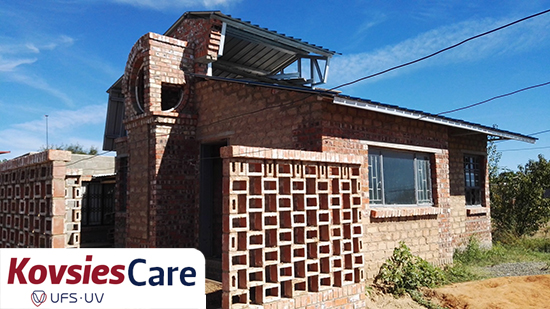12 July 2019
|
Story Leonie Bolleurs
 Students from the Department of Architecture and their lecturer, Hein Raubenheimer, building a new future for colleague Adana and her family.
In 2018 the builders decided to use a combination of clay bricks and earth bricks as major construction material.
Students from the Department of Architecture and their lecturer, Hein Raubenheimer, building a new future for colleague Adana and her family.
In 2018 the builders decided to use a combination of clay bricks and earth bricks as major construction material.
When a colleague in the
Department of Architecture bought a plot of land in 2014, her joy knew no bounds and she could not wait to share the news with fellow colleague,
Hein Raubenheimer.
Raubenheimer, a lecturer in the department, could not help but think that Adana (pseudonym) would, “like many others, promptly erect a ‘dwelling’ of affordable second-hand material”. This made him muse on how he could help in erecting a more ‘permanent’ house for her, her son and daughter.
He related: “The first-year hut-building project was in the making, and my involvement with it made me think about the possibilities of reusing the earth bricks that were formed during the building process for a potential earth-brick dwelling. However, the quality of such bricks could not be guaranteed and a more controlled manner of forming earth bricks had to be investigated.”
Interdisciplinary researchAfter talking to an architect friend, JT Erasmus, about the possibility of sustainable forms of building an informal dwelling, Raubenheimer was brought into contact with a colleague in the
Department of Chemistry,
Dr Elizabeth Erasmus. Together, he and Dr Erasmus formulated and submitted an application for interdisciplinary research. Their application was to investigate the testing of polymer-stabilised earth bricks. “To our surprise, our application was successful. The funds prompted us to immediately start preparing the site and purchasing the necessary equipment for making stabilised earth bricks,” said Raubenheimer.
He elaborated: “During the first two years, all the first- to third-year students were involved in the earthworks, foundations, and making of earth bricks. Since 2018,
Prof Gerhard Bosman, Associate Professor in the Department of Architecture, became involved with the fourth-year students, focusing on the finishing touches of the building project as well as the service components.”
Economically viableFor the project to be economically viable, the layout of the floor plan was as compact as possible (35 m²). Raubenheimer explained: “Three areas (living, sleeping, washing) were arranged to create some privacy with the minimum structure. The sleeping area was a double volume with a proposed mezzanine floor that could function as a ‘loft’ (second sleeping area).”
According to Raubenheimer, they wanted to build the entire house with stabilised earth bricks, but due to the labour-intensive and time-consuming process of making the bricks, they decided in 2018 to use a combination of clay bricks and earth bricks as major construction material.
Bloemfontein opens its heartApart from the approximately 200 Architecture students and lecturers involved in the project, the community of Bloemfontein also opened their hearts and hands widely.
“We were very lucky to get the roof sheets as donation – surplus as a result of the colour difference (
Safintra Roofing), a lightweight-steel construction company (
Siteform) sponsored the roof structure,
UFS Facilities Management donated all the windows (from their scrapyard), and a well-known Bloemfontein construction company (
Sebedisan Construction) delivered lots of recycled material with a three-ton truck. There were also several private cash donations from alumni of the Department of Architecture. Local artisans, Diphapang Machabe, April Milela, Kabelo Lando, and Petrus Letsoara also assisted with the project.
With the use of recycled material and earth bricks, the CO2 footprint of the building was minimal. Raubenheimer explained that the small areas with good North orientation, together with the good insulating properties of the earth bricks, is making the interior very comfortable throughout the year. “Good insulation of the roof and ‘loft’ will minimise the need for heating and cooling,” he said.
Hope for the future If everything runs smoothly, the project will be completed in the spring of 2019. “And then we will have a proper house-warming. Up until now, each phase of the project was an adventure for Adana. In the beginning, she could not believe that anything would come of it; but her appreciation, despite the prolonged construction period, has grown,” said Raubenheimer.
On a personal level, this project also meant a lot to Raubenheimer. “The limited finances and possibility of applied low technology, experimental forms of detailing all contributed to the adventure. The greatest learning curve for me, however, was to experience the ‘neighbourhood’. The most wonderful respect for life on the faces of neighbours and passers-by. The fact that people here seem to have nothing, but then the perception that as a community they have so much caring, time, and love for each other, has given me hope.”